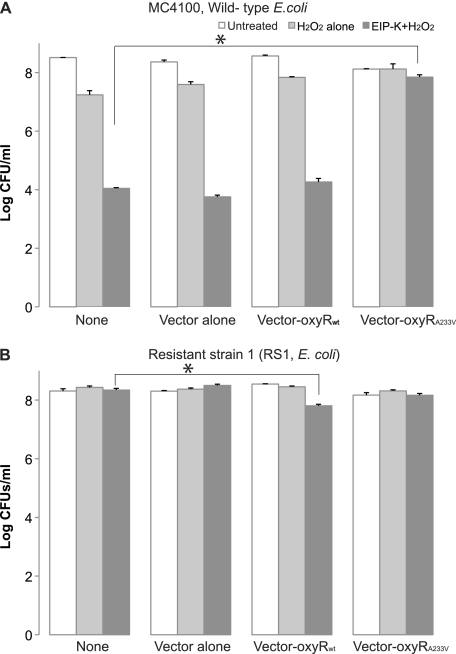Fig 6.
Complementation assay of E. coli MC4100 (A) and E. coli resistant strain 1 with plasmids containing the wild-type or mutant oxyR gene (B), using pET29a as the vector. The conditions were as follows: no vector (None), vector alone, vector plus parental oxyR (oxyRwt), and vector plus the mutant oxyR gene [oxyR(A233V)]. Each bacterial type was treated with control (ddH2O), 3 mM H2O2, and 13.75 mM EIP-K plus 3 mM H2O2. The values are means and SEM for four experiments, each run in duplicate. The asterisks indicate significant differences between cells without any plasmid (None) and any of the vector conditions under EIP-K-plus-H2O2 treatment. (A) Two-way ANOVA for the wild-type strains shows that the plasmid type effect is not significant (F[3,19] = 2.57; P = 0.085), the treatment effect is significant (F[3,19] = 91.01; P < 0.00000001), and the interaction effect is significant (F[6,19] = 9.02; P < 0.0001). Given the significant interaction effect, we performed a one-way ANOVA for the EIP-K-plus-H2O2 treatment and found a significant effect (F[3,7] = 46.64; P = 0.00005), and Scheffé post hoc tests show that the bactericidal effect of vector plus oxyR(A233V) is significantly less than that of vector plus wild-type oxyR or vector alone. (B) Two-way ANOVA for resistant E. coli strain RS1 shows a significant plasmid effect (F[3,21] = 6.33; P = 0.0031), a significant treatment effect (F[2,21] = 7.38; P = 0.0037), and a significant treatment-plasmid interaction effect (F[6,21] = 13.85; P = 0.000002). A subsequent one-way ANOVA for EIP-K plus H2O2 shows a significant effect (F[3,9] = 22.11; P = 0.00017), and Scheffé post hoc tests show that the bactericidal effect of vector–wild-type oxyR, but not vector-oxyR(A233V) or vector alone, is greater than that of the control.

